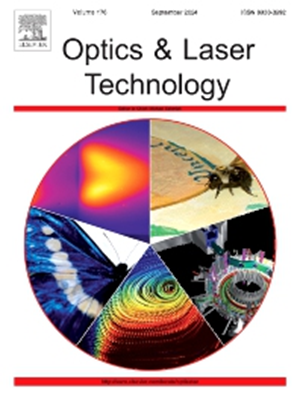TiO2的超快电子动力学及其超短激光烧蚀机理:基于电子激发和原子键断裂的修正模型
IF 4.6
2区 物理与天体物理
Q1 OPTICS
引用次数: 0
摘要
本文报道了一种改进的超短激光烧蚀TiO2的电子动力学模型。研究了TiO2在随时间密度泛函理论和Hubbard U (TDDFT + U)框架下的超短电子动力学,并建立了电子激发速率方程。针对计算激发态光学性质耗时的TDDFT + U方法,提出了一种利用DFT计算电子激发与有限电子温度相结合的新方法。采用该方法得到的TiO2介电常数的实部和虚部与TDDFT + u的数据基本一致。此外,通过透射率的理论和实验差异的比较,验证了TiO2激发态理论介电常数的准确性。在此基础上,提出了通过键断裂确定临界电子密度的新判据。对TiO2在激发态下的结构进行了弛豫,得到了临界电子密度为2.15 × 1028 m−3。最后,脉冲持续时间为240 ~ 6 ps的理论烧蚀阈值与实验数据吻合较好。本文章由计算机程序翻译,如有差异,请以英文原文为准。

Ultrafast electron dynamics of TiO2 and its ultrashort laser ablation mechanism: A modified model based on the electronic excitation and atomic bond rupture
This paper reports on a modified ultrashort laser ablation model of TiO2 via electron dynamics. The ultrashort electron dynamics of TiO2 under a time-dependent density functional theory plus Hubbard U (TDDFT + U) framework are investigated, and an electron excitation rate equation is built. Aiming at the time-consuming TDDFT + U method for computation of the optical property in the excited state, a new method of a combination of electron excitation and finite electron temperature via DFT is proposed. The real and imaginary parts of the permittivity of TiO2 obtained by the as-proposed method are almost the same as the data with TDDFT + U. Additionally, a comparison of the theoretical and experimental differences in transmission verifies the accuracy of the theoretical permittivity of TiO2 in the excited state. Then, a new criterion for determining the critical electron density via bond rupture is also proposed. The structure relaxation of TiO2 in the excited state is performed, and the critical electron density turns out to be 2.15 × 1028 m−3. Last, the theoretical ablation thresholds with the pulse duration ranging from 240 fs to 6 ps are in good agreement with the experimental data.
求助全文
通过发布文献求助,成功后即可免费获取论文全文。
去求助
来源期刊
CiteScore
8.50
自引率
10.00%
发文量
1060
审稿时长
3.4 months
期刊介绍:
Optics & Laser Technology aims to provide a vehicle for the publication of a broad range of high quality research and review papers in those fields of scientific and engineering research appertaining to the development and application of the technology of optics and lasers. Papers describing original work in these areas are submitted to rigorous refereeing prior to acceptance for publication.
The scope of Optics & Laser Technology encompasses, but is not restricted to, the following areas:
•development in all types of lasers
•developments in optoelectronic devices and photonics
•developments in new photonics and optical concepts
•developments in conventional optics, optical instruments and components
•techniques of optical metrology, including interferometry and optical fibre sensors
•LIDAR and other non-contact optical measurement techniques, including optical methods in heat and fluid flow
•applications of lasers to materials processing, optical NDT display (including holography) and optical communication
•research and development in the field of laser safety including studies of hazards resulting from the applications of lasers (laser safety, hazards of laser fume)
•developments in optical computing and optical information processing
•developments in new optical materials
•developments in new optical characterization methods and techniques
•developments in quantum optics
•developments in light assisted micro and nanofabrication methods and techniques
•developments in nanophotonics and biophotonics
•developments in imaging processing and systems

 求助内容:
求助内容: 应助结果提醒方式:
应助结果提醒方式:


